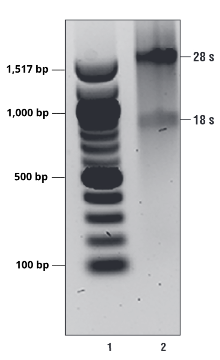| Cat. # | Size | Qty. | Price |
|---|---|---|---|
| 37739S | 100 µl |
|
| REACTIVITY | All |
| SENSITIVITY | Endogenous |
| MW (kDa) | |
| Source/Isotype | Rabbit IgG |
Product Information
| Application | Dilution |
|---|---|
| RNA Dot Blot | 1:1000 |
Note: This protocol is written for spotting either purified
total RNA or poly A-purified mRNA (titration of 2 μg, 1 μg, 500 ng,
250 ng, 125 ng, 62.5 ng, and 31.25 ng) onto a positively charged nylon
membrane using a 96-well dot blotting apparatus. Depending on the source of
the RNA, more or less RNA may be required for detection with the antibody.
Before Starting:
• RNA is sensitive to degradation by RNases, which can affect sample
integrity. It is recommended that all surfaces and equipment undergo RNase
decontamination.
• Purify total RNA and/or mRNA from cell pellet using an RNA isolation
kit. Assess total RNA quality by gel electrophoresis on a 1% agarose gel.
The 28S and 18S RNA should present as distinct bands. Smearing indicates RNA
degradation. See Figure 1.
• Cut a piece of nylon membrane to fit the size of the dot blot
manifold.
• Wet nylon membrane with 10X SSC Buffer.
• Dry membrane by placing it in a 96-well dot blot apparatus and
applying vacuum.
Optional: To normalize sample loading using methylene blue,
apply stain before Section C, Step 1 and capture an image. Rinse blots three
times for 5 min each with 15 mL dH2O. Stain does not affect
antibody binding or detection.
NOTE: Due to the kinetics of the detection reaction, signal is most intense immediately following incubation and declines over the following 2 hr.

Figure 1. Representative image of isolated, intact total RNA. 28S and 18S RNA should migrate as distinct bands. If RNA presents as a smear, the sample may be degraded and unfit to use in downstream assays. Lane 1 is NEB 100 bp DNA ladder and lane 2 is total RNA isolated from 293T cells.
posted November 2018
Protocol Id: 1784
All Species Expected
Monoclonal antibody is produced by immunizing animals with N1-methyladenosine protein.
N1-methyladenosine (m1A) is a post-transcriptional modification found in various RNA subtypes. Even though m1A was first isolated in the 1960s, lack of tools and reagents have made interrogating the epitranscriptomic landscape challenging (1,2). Most tRNAs are modified at the A58 position, which is conserved across species. Methylation at the N1 position of A58 confers a positive charge at the elbow region of the tRNA tertiary structure and does so without disrupting hydrogen bond interactions, ultimately stabilizing it (3). The enzyme complex responsible for deposition of the m1A mark on tRNA is conserved from yeast to humans. It consists of the enzymatic protein TRM61 and the substrate recognition protein TRM6 (4,5) N1-methyladenosine is also found on rRNA, and is deposited by Rrp8 in yeast and NML in mammals (6,7). The 28S rRNA undergoes methylation at position 645 in Helix 25.1, promoting 60S subunit formation (6). In mRNA, m1A modification is also present, but the relative abundance is still being quantified through various sequencing techniques (8-10). It seems most mRNA m1A sites are catalyzed by TRM6/61 and results in transcriptional repression due to the disruption of base pairing (9).
m1A, much like m6A, can be erased by various enzymes. ALKBH1 has been shown to erase the m1A mark on tRNAs, resulting in reduced translational initiation, which responds to the availability of glucose (11). ALKBH3 has also been shown to erase m1A marks from mRNA transcripts (8).
Except as otherwise expressly agreed in a writing signed by a legally authorized representative of CST, the following terms apply to Products provided by CST, its affiliates or its distributors. Any Customer's terms and conditions that are in addition to, or different from, those contained herein, unless separately accepted in writing by a legally authorized representative of CST, are rejected and are of no force or effect.
Products are labeled with For Research Use Only or a similar labeling statement and have not been approved, cleared, or licensed by the FDA or other regulatory foreign or domestic entity, for any purpose. Customer shall not use any Product for any diagnostic or therapeutic purpose, or otherwise in any manner that conflicts with its labeling statement. Products sold or licensed by CST are provided for Customer as the end-user and solely for research and development uses. Any use of Product for diagnostic, prophylactic or therapeutic purposes, or any purchase of Product for resale (alone or as a component) or other commercial purpose, requires a separate license from CST. Customer shall (a) not sell, license, loan, donate or otherwise transfer or make available any Product to any third party, whether alone or in combination with other materials, or use the Products to manufacture any commercial products, (b) not copy, modify, reverse engineer, decompile, disassemble or otherwise attempt to discover the underlying structure or technology of the Products, or use the Products for the purpose of developing any products or services that would compete with CST products or services, (c) not alter or remove from the Products any trademarks, trade names, logos, patent or copyright notices or markings, (d) use the Products solely in accordance with CST Product Terms of Sale and any applicable documentation, and (e) comply with any license, terms of service or similar agreement with respect to any third party products or services used by Customer in connection with the Products.